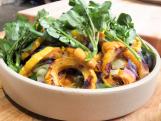Skeletons and All, El Dia De Los Muertos Is a Time for Rejoicing

With Halloween having come and gone, we're setting our sights on El Dia de Los Muertos, and learning that the two have less in common than you may think. We've got a bit of background to help demystify the Mexican holiday.
Often hailed as the 'other' Halloween, El Dia de los Muertos (The Day of the Dead in English) shares some of Halloween's ghoulish iconography, but not much more.
Centered around the gathering of family and friends, El Dia de los Muertos is about remembering the lives of those who have died. But don't be fooled! The only thing spooky about the holiday is that it's celebrated at the graveyard. In fact, it's a time for rejoicing, and many of its long-held traditions are meant to commemorate the lives of the deceased.
Foods like Pan de Muertos (or Bread of the Dead Ones) and little sugar skull candies eaten by children (pictured above) are among the most recognizable of the many traditions. Soft and sweet, the bun-shaped Pan de Muertos has strips rolled out and attached to look like bones, and the skull candies are, well, candies shaped like skulls. But other holiday traditions range from group prayer to festive dancing.

So, if El Dia de los Muertos and Halloween aren't that similar after all, why have we come to associate the two? Most likely, it's a combination of the spooky iconography that they share, and the fact that they’re celebrated so close to one another, Halloween on October 31st and El Dia de los Muertos on November 2nd. But the similarities end there, and so too should their association.
Join in on the festivities with Food2's recipe for the holiday's most popular dish, Pan de Muerto.












